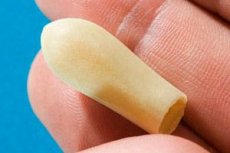Medical expert of the article
New publications
Preparations
Ovarian inflammation suppositories
Last reviewed: 04.07.2025

All iLive content is medically reviewed or fact checked to ensure as much factual accuracy as possible.
We have strict sourcing guidelines and only link to reputable media sites, academic research institutions and, whenever possible, medically peer reviewed studies. Note that the numbers in parentheses ([1], [2], etc.) are clickable links to these studies.
If you feel that any of our content is inaccurate, out-of-date, or otherwise questionable, please select it and press Ctrl + Enter.

For the treatment of gynecological diseases, the use of suppositories is usually more effective than taking tablets or injections, since the active drug begins to be absorbed directly into the vagina and immediately reaches the inflamed organ.
Suppositories for ovarian inflammation have been successfully used for many years: they are prescribed for adnexitis, salpingitis and salpingo-oophoritis. And, although it is unlikely that the disease will be cured by using suppositories alone (after all, a comprehensive approach to solving the problem is necessary), such medications will help to significantly alleviate the symptoms and speed up recovery.
Indications for the use of suppositories for ovarian inflammation
In addition to the disease associated with the inflammatory process in the appendages (adnexitis), suppositories for ovarian inflammation can be prescribed:
- for painful menstruation associated with primary or secondary pathology;
- as a postoperative treatment;
- for other inflammatory diseases of the genital area.
For a quick cure from pathology, the use of anti-inflammatory suppositories is combined with the use of other types of therapy. In particular, the doctor may prescribe injections, tablets, douches, etc.
Names of suppositories for ovarian inflammation
Hexicon |
Klion-D |
Depantol |
Indomethacin |
|
Pharmacodynamics Pharmacokinetics |
Suppositories for ovarian inflammation based on chlorhexidine, a well-known antimicrobial agent. They are active for at least 6 hours after the introduction of the suppository. |
Suppositories for ovarian inflammation based on metronidazole, have antimicrobial, antifungal action. Absorbed into the systemic bloodstream (maximum concentration in the blood is observed after 6-12 hours). |
Suppositories for ovarian inflammation based on chlorhexidine, which relieves inflammation and has a detrimental effect on pathogenic microbes. Does not disturb the balance of lactobacilli. |
Non-steroidal anti-inflammatory drug. Reduces inflammation and prevents its occurrence. |
Using suppositories for ovarian inflammation during pregnancy |
Allowed in case of extreme necessity and under the supervision of a physician. |
Not recommended for use in the first trimester and during breastfeeding. |
Allowed for use during pregnancy. |
It is not recommended during pregnancy and lactation, and is strictly contraindicated in the third trimester. |
Contraindications to the use of suppositories for ovarian inflammation |
Tendency to allergies, children under 12 years of age. |
Tendency to allergies, blood diseases, first trimester of pregnancy, lactation. |
Childhood, tendency to allergies. |
Tendency to allergies, stomach ulcers, diseases of the hematopoietic system, dysfunction of the liver, kidneys, children under 14 years of age, proctitis. |
Side effects of suppositories for ovarian inflammation |
Allergy, itching sensation. |
Itching and burning sensation, neutral vaginal discharge, changes in taste, appetite. Allergic reactions, headache, dyspepsia. |
Redness of the mucous membrane, burning sensation, allergy. |
Dyspepsia, headaches, increased fatigue, insomnia, increased blood pressure, allergies, itching and irritation of the mucous membrane. |
Method of using suppositories for inflammation of the ovaries and appendages |
Apply into the vagina, one suppository twice a day, for one week. |
Insert 1 suppository into the vagina at night for 10 days. |
Administer 1 suppository twice daily. The course of therapy is up to 10 days. |
Apply rectally, after defecation, once or twice a day (morning and night). The duration of therapy is determined by the doctor. |
Overdose of suppositories for ovarian inflammation |
There were no cases of overdose. |
Not observed. |
No cases described. |
No data. |
Interactions with other drugs |
Should not be used together with iodine or detergents. |
Should not be combined with ethanol, anticoagulants, barbiturates, muscle relaxants. |
Not compatible with anionic group preparations and soap. |
Do not use with methotrexate, digoxin. |
Storage conditions |
At temperature no more than +25°C. |
At temperature no more than +30°C. |
At t° from +10 to +20°C. |
At temperature no more than +25°C. |
Best before date |
Up to 2 years. |
Up to 5 years. |
Up to 2 years. |
Up to 3 years. |
Treatment of the ovarian inflammation should be started as early as possible, before the disease becomes chronic. Delay in treatment can cause serious complications, including infertility. To prevent the development of negative consequences, suppositories for ovarian inflammation should be supplemented with other types of therapy, such as physiotherapy, a course of antibiotics and multivitamin preparations. The treatment regimen should be determined only by a doctor during an individual appointment: self-medication in this case is unacceptable.
Attention!
To simplify the perception of information, this instruction for use of the drug "Ovarian inflammation suppositories" translated and presented in a special form on the basis of the official instructions for medical use of the drug. Before use read the annotation that came directly to medicines.
Description provided for informational purposes and is not a guide to self-healing. The need for this drug, the purpose of the treatment regimen, methods and dose of the drug is determined solely by the attending physician. Self-medication is dangerous for your health.


 [
[